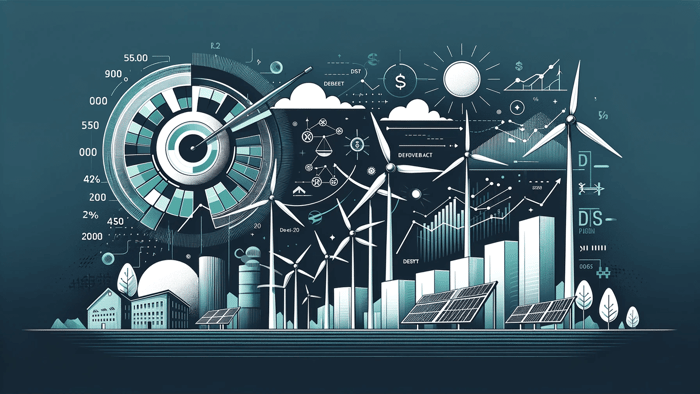Solar project finance is the process of obtaining funding for the development, construction, and operation of a solar energy project. It involves creating a solar project finance model that outlines the project's costs and expected revenue streams over its lifetime. Solar project finance typically involves a combination of debt and equity financing. Lenders and investors evaluate the project's financial viability based on factors such as IRR, capital costs, operating expenses, energy production, and revenue from energy sales or other incentives. By securing financing for a solar project, developers can access the capital they need to build and operate the project, while investors can benefit from the long-term, stable returns associated with solar energy investments.
How to develop a financial model for solar investments?
When developing a financial model for solar project finance investments, it's important to consider the following factors:
1. Accuracy: The financial model should be as accurate as possible in its projections of costs, revenues, and cash flows over the life of the project. This involves incorporating data and assumptions about factors such as full load hours, solar degradation, EPC & EPCM costs, and operational expenditures.
2. Sensitivity analysis: The financial model should include sensitivity analyses to assess the impact of different variables on the project's financial performance, such as changes in energy production on a P50, P75, and P90 basis, energy prices, operational expenditures, or capital costs.
3. Financing structure: The financing structure of the solar project can significantly impact the value of a solar asset which is why a robust and flexible financial model is of utmost importance to increase the valuation of a renewable energy asset.
4. Risk assessment: The financial model should incorporate a risk assessment that identifies and quantifies the risks associated with the project, such as the consideration of different asset lifetimes, reduction of energy production, fluctuation of PPA prices, or changes in regulatory frameworks.
5. Investor perspective: The financial model should be developed from the perspective of potential investors, including providing clear and transparent assumptions, outputs, and metrics that are relevant to investors' decision-making processes. Investors often want to maximize the Internal Rate of Return of an investment which is why a financial model should clearly reflect potential IRR maximization strategies such as debt sculpting in accordance with a target DSCR.
Maximizing debt in a solar project finance deal through sculpting debt with a minimum DSCR target
Debt sizing with a target debt service coverage ratio (DSCR) is a method used in project finance to determine the appropriate amount of debt financing that a project can support while maintaining a certain level of debt repayment capacity.
What is the Debt Service Coverage Ratio (DSCR)?
The debt service coverage ratio (DSCR) is a financial metric that measures a project's ability to generate enough cash flow to cover its debt service obligations, including principal and interest payments. A DSCR of 1.0x indicates that the project generates enough cash flow to cover its debt service obligations, while a DSCR above 1.0x indicates that the project generates more cash flow than required to cover its debt service obligations.
When sculpting a debt profile to match a target DSCR, solar project finance teams will use CFADS to determine the amount and timing of debt payments required to meet the target DSCR. The process of sculpting a debt profile involves structuring the debt payments to match the expected cash flow available for debt service over the life of the project.
To determine a sculpted debt repayment profile considering a target Debt Service Coverage Ratio (DSCR) of 1.30x, the following steps can be taken:
1. Calculate the Cash Flow Available for Debt Service (CFADS) for each year of the solar project finance deal based on the project finance model. CFADS represents the cash generated by the project that is available to service debt obligations, after taking into account all operating expenses, taxes, and other required payments.
2. Determine the annual debt service for the project based on the financing terms (e.g., interest rate, tenor, payment frequency, etc.). This represents the total amount of principal and interest that needs to be paid each year to service the debt.
3. Calculate the DSCR for each year by dividing the CFADS by the annual debt service. The DSCR represents the project's ability to generate enough cash flow to meet its debt service obligations.
4. Identify the years in which the DSCR falls below the target DSCR of 1.30x. These are the years where the project is at risk of not being able to meet its debt service obligations.
5. In order to sculpt the debt repayment profile, allocate additional principal payments in the years where the DSCR is above the target level, which will reduce the outstanding principal balance of the loan. This will help to reduce the debt service obligation in future years.
6. The additional principal payments should be calculated such that the DSCR is maintained above the target level in the years where the payments are being made. This can be done by adjusting the size and timing of the additional principal payments.
7. Continue to adjust the debt repayment profile until the DSCR is maintained above the target level in all years of the project.
Overall, a sculpted debt repayment profile helps to ensure that debt service obligations are manageable throughout the project's life and that the project can meet its financial commitments. By adjusting the repayment profile based on the CFADS and the target DSCR, lenders can mitigate the risk of default and ensure that the project is a successful solar project finance deal over the long term.
Enhance the decision-making process of your organization with a comprehensive financial model dashboard.

If you're looking to invest in renewable energy, you need a comprehensive financial model dashboard that summarizes all the key investment metrics relevant to your decision-making process.
This financial model dashboard for renewable energy investments is designed to help you make informed investment decisions with ease. It includes a detailed breakdown of the project's capital structure, allowing you to understand the financing mix of the project and the risks associated with each layer of the capital stack.
The dashboard also considers critical investment metrics such as IRR and NPV on both a levered and unlevered basis, giving you a complete picture of the project's profitability.
In addition to these essential investment ratios and multiples, the dashboard details the payback periods, CFADS/EV, Revenue/EV, EV/MWp, and EV/MWh. These metrics are crucial in evaluating the financial viability of the project and determining its potential for generating returns over the long term.
The dashboard also features eye-catching charts that provide a visual representation of the project's cash flow generation over its entire asset lifetime. This feature will give you valuable insights into the project's cash flow patterns and help you make informed investment decisions.
With all these critical investment metrics and data points in one place, this financial model dashboard is the ultimate tool for renewable energy investment decision-makers.






